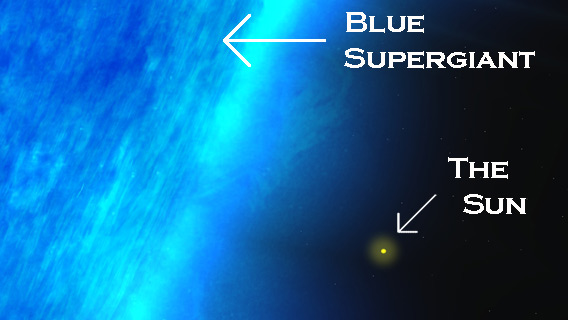When Supermassive Supergiants Go Superboom
SLATE
Posted Friday, April 19, 2013, at 8:00 AM

Artist drawing of a gamma-ray burst, a cosmic explosion announcing the birth of a black hole.
Image credit: NASA/Dana Berry/Skyworks Digital
Image credit: NASA/Dana Berry/Skyworks Digital
I have long been fascinated by gamma-ray bursts (or GRBs). These are incredibly
violent events: It’s like taking the Sun’s entire lifetime energy
output and cramming into a single event that lasts for mere seconds! The
energy emitted is so intense, so bright, we can see GRBs from a
distance of billions of light years.
Gamma rays themselves are just a form of light, like the kind we see,
but with huge energy; each photon is packed with millions or billions
of times the energy in a single photon of visible light. Only the most
energetic events in the Universe can make them, so if we detect a burst
of them coming from the sky, we know something literally disastrous has
happened.
We know GRBs come in many flavors. Some last literally for
milliseconds, while others stretch on for minutes. We also know
different events can cause them, too. Short ones seem to come from merging neutron stars, ultra dense compact objects left over after stars explode. The longer ones occur when massive stars explode, leaving their cores to collapse. In both cases, the huge blast of high-energy gamma rays signals the birth of a black hole.
But astronomers were recently surprised to find a third type of GRB, one that lasts not for minutes, but for hours. Whatever these objects are, they don’t just flash with light, they linger, blasting out far, far more gamma rays for far, far longer than was previously thought. What could do such a thing?
Several ideas were put forth, but new observations provided the linchpin: an ultra-long-duration GRB occurred on Christmas Day in 2010, and its distance was found to be a soul-crushing 7 billion
light years away, about halfway across the visible Universe! This left
only one possible candidate for the progenitor: a hugely massive star,
one so big it dwarfs the Sun into insignificance.
The stars causing these slow GRBs have at least 20 times the mass of
the Sun, and are extremely hot and luminous. We call these stars blue
supergiants, for good reason: They are so big that if you plopped one in
the center of our solar system, their surfaces could reach nearly to
the orbit of Jupiter! They can be 1000 times wider than the Sun.
These supergiants use up their fuel rapidly, living for only a
million years or so before running out (compared to the Sun, which has a
lifespan of 10 billion years or so). When the tank of a blue supergiant
runs empty, the core collapses, forming a black hole.
The processes are complicated, but this sets up conditions where twin
beams of matter and energy blast away from the stellar core, eating
their way out of the star. It takes a while to reach the surface—even at
the speed of light, it would take an hour to get from the center to the
edge—and when they do, the beams blast outward, pouring gamma rays into
the Universe. But the star is so huge that it takes several hours for
the event to play itself out, which is why we see these GRBs lasting
such a long time.
I’ll note these are different than the GRBs that last for a few
minutes, even though both come from massive stars. Some massive stars
blow off their outer layers before exploding; these are called
Wolf-Rayet stars, and by the time they go supernova they are little more
than the core of the star surrounded by rapidly expanding gas clouds
that used to be their atmospheres. Because they are small(ish), the GRB
event lasts only minutes. The blue supergiants retain their atmospheres
before exploding, making them far larger, so the explosions take a lot
longer.
This is pretty cool news. GRBs were only first discovered in the
1960s, and for a long time very little was known about them. As we
launched better telescopes into space we learned more, but found that
every GRB is different, making them hard to classify into broad groups.
So even now, decades later, we’re finding new ways the Universe can make
these ridiculously dramatic events. Only three of these ultra-long
bursts have been found, but more will be uncovered eventually.
That makes me happy. There’s still a lot to learn about the cosmos,
and if it can make it hard to observe what are literally the brightest
explosions in the Universe, what else is out there to find and understand?


0 Comments:
Post a Comment
<< Home